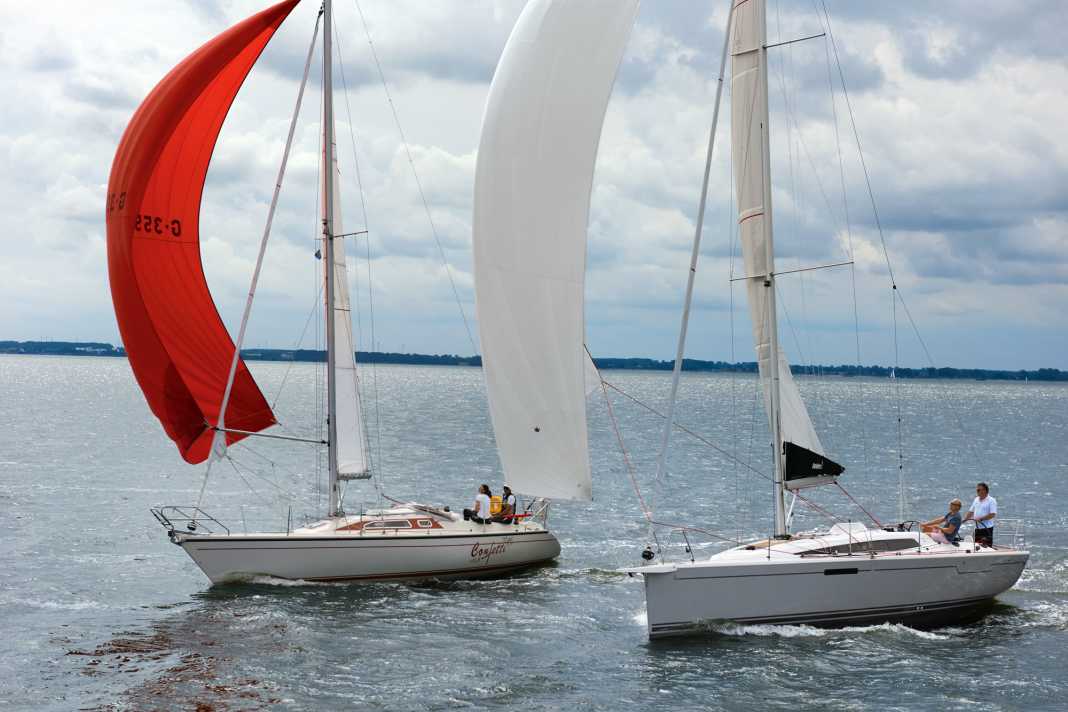





In this article:
A new 34-foot production boat does not necessarily have to raise the blood pressure of anyone interested in boating. Not even if it comes from a renowned shipyard and was designed by well-known designers. However, if it is a Dehler in this common size, things get more exciting. After all, the oldest German series shipyard always ranks in the top three in YACHT surveys when it comes to boat ownership or even dream yachts.
More importantly, Dehler has created something special in recent years. With its older sisters, the shipyard has already shown that the performance cruiser is alive and well and can make numbers. The Dehler 38 marked the start in 2013 and was immediately honoured several times, including with the prestigious European Yacht of the Year award. This was followed by the 46 and the 42, all highly acclaimed models from the much talked about segment of the sporty, regatta-capable and yet comfortably habitable modern boat. A credo that Dehler has always lived by and which has not changed since Hanseyachts took over the brand from Freienohl in 2013.
The Dehler 34 as a prototype of the performance cruiser
Then in 2016 came the 34, which would replace the then established 35-foot design by Simonis/Voogd. At last, one almost wanted to exclaim at the time. Because the size was easy to handle for the usual crew size of two and therefore also for small families, the price could be made affordable within the realms of possibility and also because the first Dehler 34 is regarded as the prototype of the modern performance cruiser.
That was in 1980, the heyday of the International Offshore Rule, a time that many today would still describe as good or even golden. With the db1 and later the 2 (see below), Dehler won international silver medals up to the world championship title and launched the boat in series production. It was to be built around 1300 times in various derivatives from the Dehler to the Optima 106 - a record that still stands.
Dehler, a sailing dynasty
Shortly after the presentation, she was ready for the YACHT test, the Dehler 34, at the delivery jetty in Greifswald. Wide aft, open stern, closed by a hatch, the striking dynamic superstructure with the elongated cat's eyes, a high rig, the bow extended with a GRP sprit.
In the cockpit: Karl Dehler works with a tape measure, notepad and Dyneema straps. "Kalle", as everyone calls him, is in his element and, as always, full of vigour. Fine-tuning. The stern stays on both sides are still in the way of the helmsman, they are tied on with blocks. The project manager had already joined the Hansegroup before the Dehler shipyard did; now the two are together again. A great gain, also because the man with the name stands up for his actions.
And the circle closes further, next door is an Optima 106 from 1987, a derivative of the old Dehler 34 for comparison with the current edition. It belongs to Kalle's daughter Rebecca. The former German 420 champion, together with her brother Thomas, would like to go on a blue water voyage in the boat developed by her grandfather. A sailing dynasty, after all.
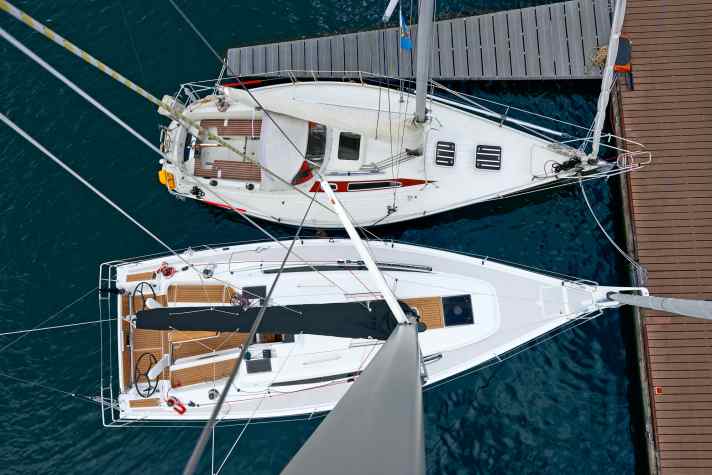
The Dehler 34 outruns the Optima 106
Out of the Ryck, through the still manually operated Wiecker wooden bascule bridge onto the Greifswalder Bodden. Even the quickly set space sails bear witness to the change in times. The crew on the old Dehler has to rig a boom with topgallant and downhaul and sheets with barber haulers for the spinnaker. On the new one, the foredeck is not even entered to set the gennaker on the nose. And the speeds? The new 34 easily passes the Optima at will. The amazing thing: The old boat even has a little more sail area in relation to its weight, and has a sail carrying capacity of 4.9 compared to the 4.8 of the Dehler 34. It should actually be able to hold its own against the new boat. However, the less resistant hull, a smoother underwater hull and fresher sails seem to stand in the way.
A similar picture emerges on the cross in around 12 knots of wind. The old Optima sails well and also quite high, but lacks a larger genoa; the new boat is clearly superior. Kalle Dehler: "Despite the higher hull, we have more stability thanks to the more modern keel and greater width."
Stable sailing, even in a lay-up
In these conditions, the Dehler 34 from 2016 delivers speeds of around 6.5 knots high upwind with turning angles of less than 90 degrees. The steering is also impressive. The new model develops the favoured light rudder pressure, which is easy to adjust using the traveller and mainsheet. With one and a quarter turns from stop to stop, she steers beautifully direct. She is agile when tacking and takes waves dynamically. In later gusts, the Judel/Vrolijk design is characterised by a high degree of stability; even with more heel, there is no tendency to sunshake.
Kalle Dehler: "That was a very important point in the design. We therefore positioned the rudder further forwards, where it runs no risk of drawing in air if there is a lot of lean, which can lead to a stall from above, which can continue right down to the bottom in a flash." For this reason, it was also accepted that the rudder coker at the foot end runs through the berth cushion in the aft cabin on the inside of the partition wall to the forecastle.
The Dehler 34 can be converted quickly for single-handed sailing
In any case, the Dehler 34 is a pleasure to steer, which is also helped by the neat seating positions. On a boat of this size, it is a battle for centimetres for the designers, especially with a split backstay, which has great disruptive potential for the helmsman if he wants to stand behind the wheel. This is because the superstructure needs space for the interior, the thwarts need length for sitting and lying down, then there are the wheels - and things get tight aft. On the Dehler, the compromise was successful.
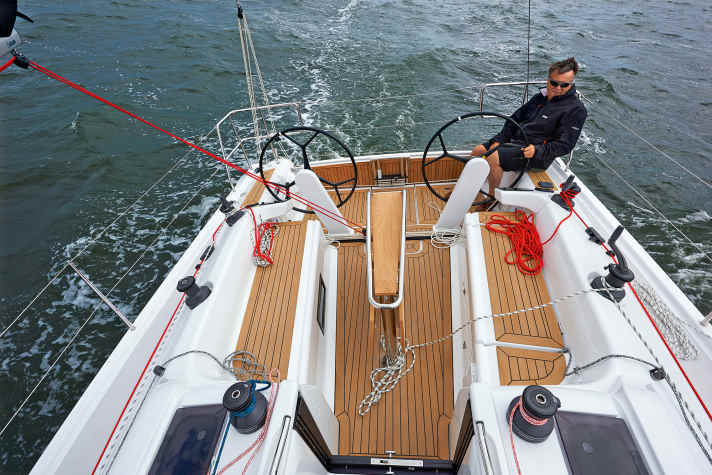
And there was even room for the plotter pods: elegantly stylish consoles for the electronic charts. However, this requires a double design and two plotters if you want to have a good view and direct access to the instruments from the wheel you are using.
Speaking of accessibility: the genoa sheets run on winches in the usual forward position in the coaming. And the ropes of the German Sheeting System end on drums that can be reached directly from the helmsman and can be disconnected. The horizontal lever stoppers for the mainsheet and the sheet guides also make it possible to lead both sheets to the aft winches: the genoa sheet to leeward and the mainsheet to windward. To tack, the mainsheet is disconnected to windward and the genoa is hauled tight there during the manoeuvre. Once the genoa has been released in the old lee, the winch is free for the mainsheet again. This makes the boat perfectly suitable for single-handed sailing and small crews.
The return of the tiller
The boat is equipped with a tiller as standard. Due to the forward position of the rudder, this extends quite far into the cockpit. This can be inconvenient when racing with several people, as it becomes cramped at the front of the cockpit between the genoa winches and the companionway. When cruising, however, the helmsman sits almost under the sprayhood and can reach all the winches without having to jam the sheets. Our prediction: very few people will choose the tiller, even if the wheel system costs extra. Wheels have become established, they are considered by many to be more manoeuvrable and offer more space.
A 1.95 metre deep keel is also standard, a large dimension for a 34-foot boat. The flat version is 1.55 metres deep and 125 kilograms heavier; the performance keel from the Competition package extends a full 2.10 metres into the water and is 400 kilograms lighter than the basic version. There are also corresponding rudder blades; the Competition profile can be thinner due to the more resilient, lower-dimensioned aluminium shaft. In any case, self-aligning rudder bearings are used. The Jefa twin-wheel system works with just one rope, which is slightly cheaper to produce but does not result in any redundancies in the event of damage.
The standard version of the rig features a two-beam Seldén profile, while the competition version is around 70 centimetres longer and, in addition to the Rodrigg, offers six square metres more cloth to the wind. The sports version is also available in carbon fibre. The basic price already includes Elvström's triradially cut so-called FCL sails (Fast Cruising Laminate). The high-quality cloths have little in common with standard OEM products. They have a clean design, are easy to trim, maintain their profile even in stronger winds and are expected to be highly durable. The four full-length battens in the main are also a sign of the latter.
By sailors for sailors
In any case, the deck and its layout are impressive in terms of function and features. Examples: The seating positions in the cockpit are excellent, and a recess in the dents provides support for the feet when sitting comfortably on the coaming. The main and genoa halyards are fitted with low-stretch Dyneema cores. The genoa rails provide a sheeting angle of 12 degrees. This can be effectively reduced with optional inhaulers. The genoa carriages are line-adjustable. Ten stoppers in the halyard swivel are sufficient. The fixed boom kicker is on board as standard. The halyards disappear into deck hatches when required. The plug-in bulkhead is telescopic. Sensibly positioned handholds on the companionway, cockpit table and cabin roof provide safety. All in all, effective solutions from sailors for sailors - sometimes bypassing the accountants. This is what we have come to expect from Dehler.
We don't want ships that have been pre-rigged!" (Karl Dehler)
Dehler has always stood for development based on practical experience; it is a latent rule that runs through the company's history: clever ideas, the odd innovation, good manoeuvrability and decent sailing behaviour even in winds of less than ten knots. "Then as now: we don't want ships that have been reefed at the shipyard!" says Karl Dehler. All of this also applies to the new Dehler 34.
Modern lines with a chance of timelessness
Once we arrive in Stralsund's beautiful city marina, the differences between the first and the latest performance cruiser become apparent again. While the bowsprit of the new boat almost pokes into the power box on the jetty, making it difficult to disembark, on the flat-bottomed old Optima it is just a step over the integrated small bow ladder; the old boat has significantly less freeboard. The clearly larger overall volume of the new ship and the much wider stern are striking.
Below deck, the modern lines continue on the new boat, bringing with them a chance of timelessness. As with its sisters, the interior is characterised by a commitment to curves and a departure from right angles. Once again, the wall units with their rounded flaps are striking and conceal a detail that is as laudable as it is creative: the horizontal upper surfaces of the units have ventilation slots. The LED strip glued to the rear edge of the flap provides indirect lighting, even in the cupboards. Just one detail.
The interior of the Dehler 34 is also a joy to behold
A positive. Just like the drawers under the sofas, whose contents are easy to reach. Or the programmable lighting system with dimmers, spotlights and light strips. The spacious bathroom with a door that separates either the entire wet room from the saloon or just the shower and toilet area from the washbasin area. Or the fixed mattresses, the easily accessible engine compartment.
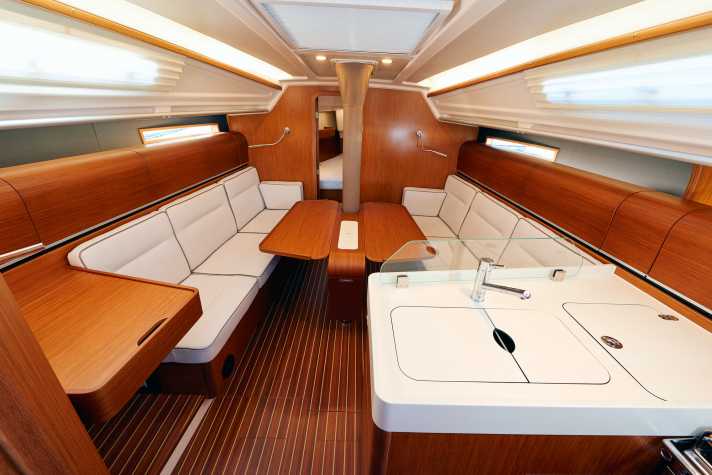
Like the rest of the boat, the interior is simply a joy to behold and is pleasant, inviting and cosy. If you look behind the scenes or just look closely, you will hardly ever be disappointed. Although there are occasionally unclean corners and joints in the fittings, which could perhaps be better executed in series production, the carpentry work is characterised by a good semi-industrial standard overall. The installations are accessible and easy to follow. A look into the bilge reveals a floor assembly with closely spaced compartments made of frames and stringers as well as large shims for the keel bolts. The mast, which has been pushed through, stands securely on an adjustable foot.
Carbon in the backbone
The Dehler 34 can also offer something in the invisible: The floor assembly is carbon reinforced. In the first two layers of the hull, the laminators use the higher quality and osmosis-resistant vinyl ester resin. The deck and hull are made by hand from a sandwich with a balsa wood core. Aluminium plates are laminated into the deck for all fittings so that the inner shell of the canopy does not have to be opened for subsequent assembly.
The boat is only available in the test version with a cabin on the starboard aft side and a large aft locker; this can also be accessed via the bathroom if desired. There is a choice of finishes for the furniture, floor and worktop in the galley, and of course there are various options for the upholstery. But the competitive spirit does not stop below deck either: for an extra charge, the lockers in the forward and aft cabins are available in lightweight material.
The Dehler 34 is another great success
Keels, sail areas, deck layout, steering, interior: the Dehler 34 offers almost maximum variance for sailors. It can therefore be configured as desired across the entire spectrum between an almost conventional touring boat or an ambitious cruiser/racer.
Back to Greifswald. Cruising in increasing wind is on the programme. Once again the boat remains under control and confirms the good impression from the previous day, even with more wind, delivering speeds of up to 7 knots. And the old Dehler 34? Sails her course stubbornly, is a little less sensitive and, above all, wetter. The crew sits closer to the water and feels like they are on a smaller boat. She has less space in the cockpit and below deck.
The prototype arrives almost 30 minutes earlier after around four hours. More decisive than speed is the package of all aspects of sailing fun and comfort. And Judel/Vrolijk and Kalle Dehler's team have once again achieved a great success.
Dehler - A German success story
After Dehler celebrated its first international successes with the seven-metre Sprinta Sport keel yacht, shipyard founder Willi Dehler wanted to continue the concept of the touring regatta boat and transfer it to the now popular ten-metre size.
Together with sailmaker Berend Beilken from Bremen and Dutch designer Cees van Tongeren from the Van de Stadt office, Dehler designed a three-quarter tonner according to the current International Offshore Rule (IOR) in 1979 and christened the type db1 (after Dehler and Beilken). Although the boat took into account the widespread but increasingly radical IOR, it was not a formula drudge with extreme measuring bumps. The hull was characterised by harmonious lines, like a good cruising boat. However, it had a steel floor assembly, a tubular lattice frame stiffening the hull, the halyards were recessed, the foot railing on the foredeck was foldable and the interior was made of foam panels.
The first series three-quarter tonner "Luv" won the SORC, the most important regatta series in the USA, off Kiel, Cowes and Miami. The ship and shipyard were instantly well-known, and honours at boat shows in Paris and London followed. At the world championships in the class from 1980 to 83, the ship finished as runner-up and series world champion. However, the titles went to various individual designs.

Then the World Championship was to take place in Kiel, the home turf of the db yachts. Dehler upgraded and upgraded. The Freienohlers brought out the db2, a radical further development that moved away from the original idea of the comfortable regatta boat and was adapted as a concession to the increasingly faster individual IOR constructions, with a surveying hook in the stern and the engine directly above the keel. The uncompromising regatta boat only had an interior reduced to conform to the rules. The sail area was increased, there was a more filigree mast, typical of the class with neutral spreaders and double backstays, the waterline grew and the centreboards were moved into the cut-out superstructure. The keel and rudder were given elliptical shapes, a design by the young naval architect Torsten Conradi (who today is one of the owners of Judel/Vrolijk, who designed all Hanseatic and Dehler yachts, including the 34).
Conradi, Kalle Dehler and Co. won, and db2 production boats also sailed to second, third and fifth place, followed by further successes in the USA and Japan. Nevertheless, Willi Dehler stopped production in 1986 and did not produce any new series regatta boats, as the one-offs became too popular again, which also drove up costs.
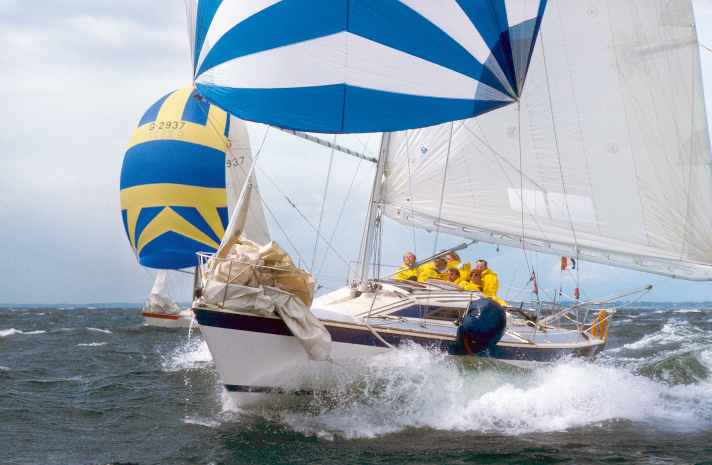
The harmonious shapes of the db1, however, gave rise to the Optima 101 cruising boat, which was launched in 1985. A ship in this series was also called "Luv" and was successful: victory in the North Sea Week off Helgoland and in the stormy Skagen round-the-world race to Kiel. A year later, the Optima 106 emerged from the model. The toilet and galley were located aft, as they are today, and there was also an optional wheel steering. The model was renamed Dehler 34 to conform to international conventions and to indicate the shipyard and the size in feet instead of fantasy names.
It became a worldwide success; around 1300 boats of the same type are almost unimaginable today. Kalle Dehler: "The Dehler 34 ties in very nicely with the Optima, even though it offers much more space and comfort and sails much better than the regatta boat from back then. But we have to come up with figures like that first."
Measured values Dehler 34
Sailing performance, without drift and current
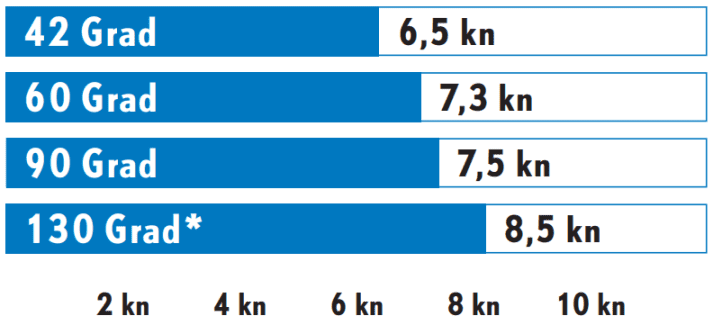
Wind speed: 11-13 kn (4 Bft.), wave height: approx. 0.1 metres
* with gennaker
Potential

The value applies to the Competition version, the normal version comes in at 4.4
1: Dimensionless number. Calculation: 2√S/3√V. The higher the value, the more sail area (S) the ship has in relation to the displacement (V)
Bunk mass
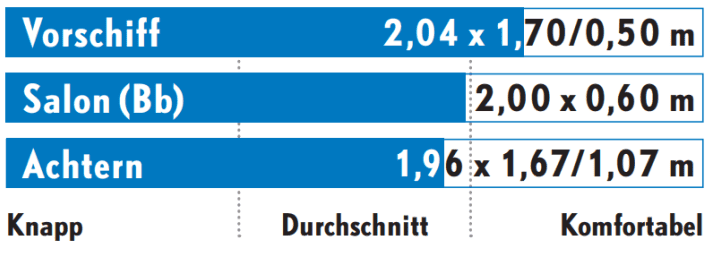
Standing height
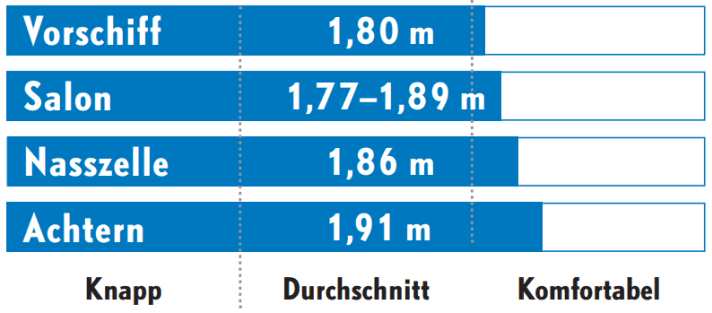
Sound pressure
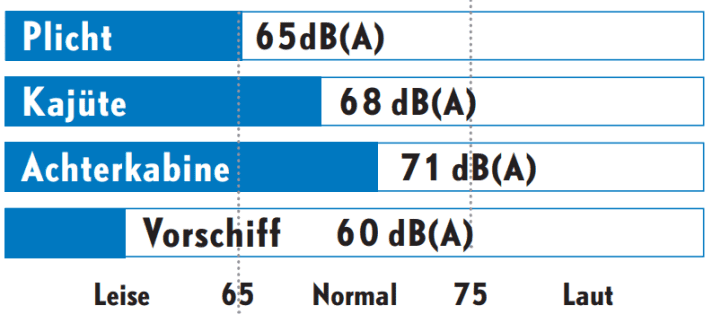
Measured at cruising speed (80 % of maximum speed): 5.7 kn, 2,200 min -1
YACHT rating Dehler 34
With the Dehler 34, the shipyard has not only continued the concept of the successful 38 and its younger sisters, but also developed it further. The bow nose and plotter pods are two examples of this. Otherwise: a mature, successful boat for modern sailors that can be customised to suit many preferences
Design and concept
- + Many power levels selectable
- + Modern-timeless lines
- + Reasonable pricing
Sailing performance and trim
- + High performance potential
- + High stability
- + Good trimming options
Living and finishing quality
- + Pleasing interior fittings
- + Separable shower/room
- + Drawers under the sofas
Equipment and technology
- + Upscale basic equipment
- + Storage space in the rear optimally utilised
- - Minor expansion defects
The Dehler 34 in detail
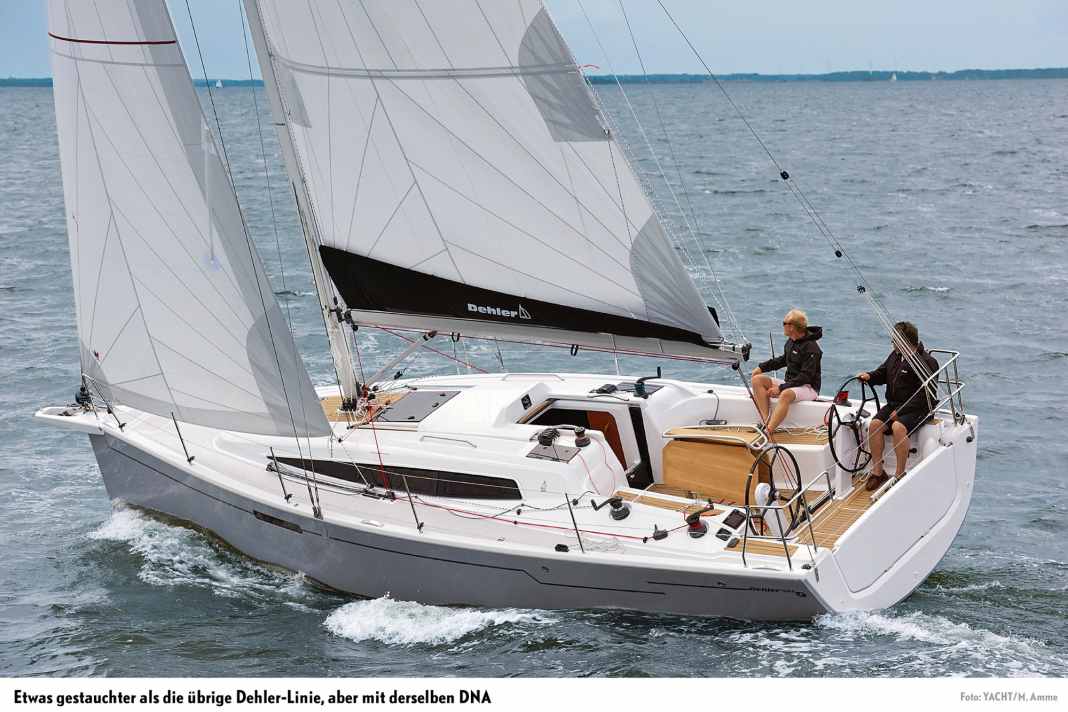





Technical data Dehler 34
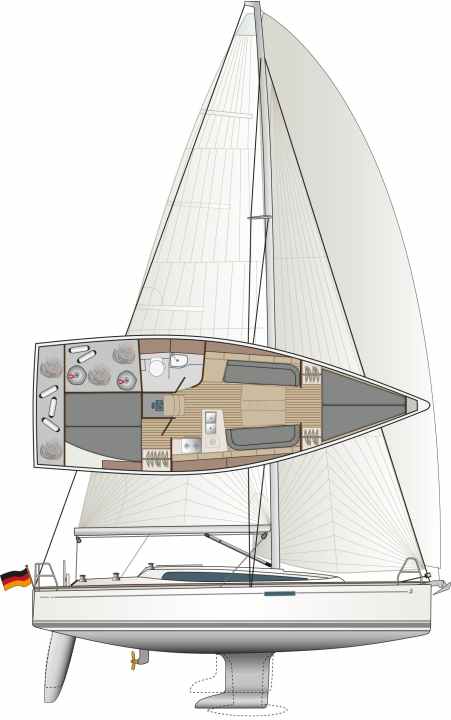
- Design engineer: Judel/Vrolijk & Co
- CE design category: A
- Torso length: 10,30 m
- Total length: 10,70 m
- Waterline length: 9,60 m
- Width: 3,60 m
- Draught/alternative: 1,95/2,10, 1,55 m
- GPH race value: 633 sec/nm
- Weight/alternative: 5,95/5,45, 6,10 t
- Ballast/alternative: 2,10/1,70, 2,25 t
- Mast height above waterline/alternative: 16,27/17,02 m
- Mainsail/alternative: 37,5/41,0 m²
- Furling genoa (105 %)/alternative: 27,5/30,0 m²
- Machine (Volvo): 13 kW/18 hp
- Fuel tank (plastic): 160 l
- Fresh water tank (plastic): 230 l
- Holding tank (plastic): 35 l
Hull and deck construction
Sandwich with balsa wood core using the hand lay-up method. Bulkheads attached with angle laminate, hull deck glued and partially laminated
Base price ex shipyard
225,981 euros, gross incl. 19 % VAT (as at April 2025)
Shipyard
Dehler, Ladebower Chaussee 11, 17493 Greifswald; www.dehler.com
YACHT rating Optima 106
This rather sporty and tried-and-tested boat impresses with its complete holiday suitability and solid construction; it was built over 1300 times in different versions. A real used boat tip
Design and concept
- + High ballast content
- + Favourable used boat price
- - Flat hull, narrow stern
Sailing performance and trim
- + Solid properties
- + Plenty of sail area
- + Simple trimming devices
Living and finishing quality
- + Seaworthy saloon berths
- + Successful room layout
- + Clean interior fittings
- - Headroom tight
Equipment and technology
- + Functional deck layout
- - Original motor only single-circuit cooled
Dehler Optima 106 in detail






Technical data Optima 106
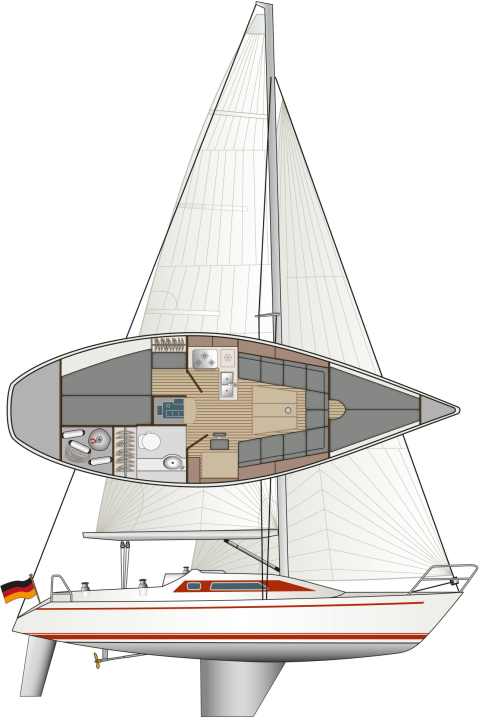
- Design engineer: Van de Stadt
- Torso length: 10,10 m
- Total length: 10,60 m
- Waterline length: 8,60 m
- Width: 3,40 m
- Draught/alternative: 1,70/1,45 m
- Weight: 3,8 t
- Ballast/proportion: 1,8 t/47 %
- Mainsail: 27,8 m²
- Genoa: 32,8 m²
- Sail carrying capacity: 24,9
- New price 1982: 57,350 Euro
- Used boat price (ø): 30,000 euros
This test appeared in YACHT issue 19/2016 and was revised by the editorial team in April 2025.

